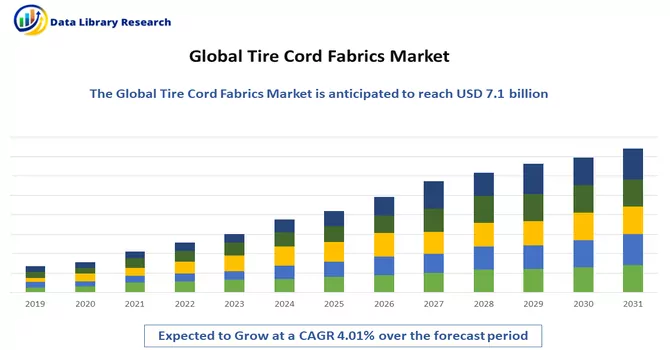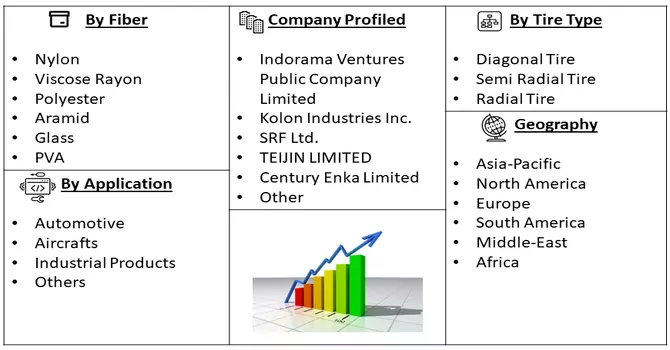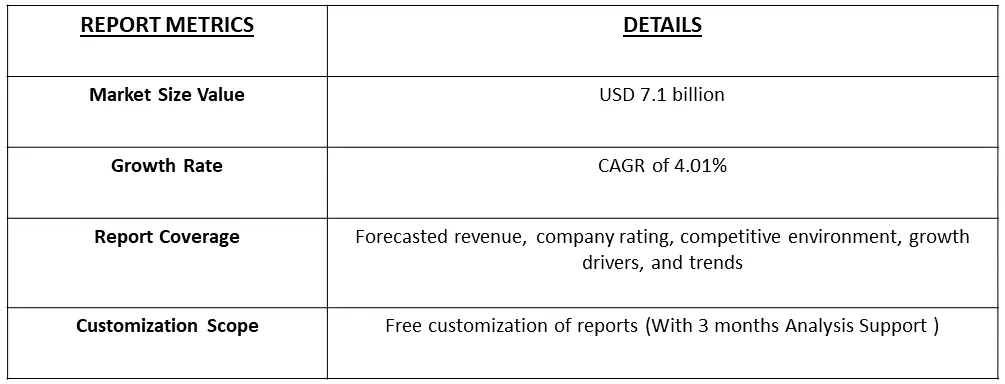The global tire cord fabrics market size was valued at USD 7.1 billion in 2023 and is anticipated to expand at a compound annual growth rate (CAGR) of 4.01 % from 2024 to 2031.

Get Complete Analysis Of The Report - Download Free Sample PDF
Tire cord fabrics are specialized textiles used in the construction of automobile tires to provide strength, stability, and reinforcement. These fabrics are typically made from materials with high tensile strength, such as polyester, nylon, or aramid fibers. The tire cord fabric is embedded within the tire's rubber compound during the manufacturing process, forming layers that enhance the tire's structural integrity and performance. The primary functions of tire cord fabrics include reinforcing the tire to withstand the internal air pressure, resisting the forces encountered during vehicle movement, and contributing to the tire's overall durability. The specific construction and material composition of tire cord fabrics are designed to meet stringent requirements for tensile strength, flexibility, and resistance to heat and fatigue. Different types of tire cord fabrics are used for various tire applications, ranging from passenger cars to heavy-duty trucks and industrial vehicles. The use of high-quality tire cord fabrics is crucial in ensuring the safety, longevity, and performance of tires under diverse driving conditions.
The increasing appetite for passenger cars in emerging economies, coupled with a rising inclination toward durable and fuel-efficient tires, is anticipated to be a key driver for the demand of tire cord fabrics in the foreseeable future. The expanding adoption of electric vehicles is poised to further bolster this demand. Notably, traditional tires tend to wear approximately 30% faster on electric vehicles compared to their conventional counterparts. In response to this, manufacturers are increasingly turning to aramid fibers to craft exceptionally lightweight and wear-resistant tires, particularly tailored for the electric vehicle industry. Within the U.S. market, the dominance of nylon tire cord fabric is notable, showcasing the material's prevalence and significance in meeting the evolving demands of the automotive sector.
The tire cord fabrics market is witnessing significant trends that are reshaping the industry landscape. With the growing demand for electric vehicles, there is a notable shift towards specialized tire cord fabrics designed to address the unique wear patterns associated with electric vehicle tires, utilizing materials like aramid fibers. Fuel efficiency remains a key focus, driving innovations in materials and construction techniques to reduce rolling resistance. The market is expanding in emerging economies with the rise of the middle class and increased urbanization. Sustainability is a prominent trend, prompting manufacturers to explore eco-friendly materials and smart technologies, including embedded sensors for real-time tire performance monitoring. Market consolidation through mergers and acquisitions, along with a focus on tire recycling, customization for specific applications, and adherence to regulatory standards, are further influencing the tire cord fabrics market. This dynamic landscape reflects the industry's response to technological advancements, environmental considerations, and the evolving automotive sector.
Market Segmentation: The Global Tire Cord Fabrics Market Growth and it is segmented by Fiber (Nylon, Viscose Rayon, Polyester, Aramid, Glass, and PVA), Tire Type (Diagonal Tire, Semi Radial Tire, and Radial Tire), Application (Automotive, Aircrafts, Industrial Products, and Others), and Geography (Asia-Pacific, North America, Europe, South America, and Middle-East and Africa).

For Detailed Market Segmentation - Download Free Sample PDF
Market Drivers:
Rising Automotive Production
The sustained expansion of worldwide automotive production, propelled by a rising consumer appetite for vehicles, stands as a fundamental catalyst for the tire cord fabrics market. The escalating manufacturing output of vehicles directly correlates with an increased need for tire cord fabrics, integral for reinforcing tires. As the automotive industry experiences heightened demand, particularly from consumers worldwide, the concurrent surge in the production of vehicles underscores the indispensable role of tire cord fabrics in meeting the escalating requirements for robust tire reinforcement. This interdependence accentuates the pivotal role played by the growing automotive sector in driving the demand and subsequent market growth of tire cord fabrics.
Increasing Demand for High-Performance Tires
The increasing inclination toward high-performance tires, distinguished by attributes like enhanced traction, durability, and fuel efficiency, is a key factor propelling the demand for sophisticated tire cord fabrics. These fabrics assume a pivotal role in elevating the overall performance and safety standards of top-tier tires. As consumer preferences lean towards tires that deliver superior traction on various terrains, prolonged durability, and improved fuel efficiency, the demand for advanced tire cord fabrics becomes imperative. These fabrics, strategically integrated into tire construction, contribute significantly to the heightened performance characteristics and safety parameters of high-quality tires, aligning with the evolving expectations of the market for top-notch tire performance.
Market Restraints:
Environmental Concerns and Regulations
The escalating environmental concerns associated with the tire industry, particularly regarding issues like tire disposal and pollution, are poised to instigate more rigorous regulatory measures. Adhering to evolving environmental standards demands a constant commitment to innovation and adaptability, presenting considerable challenges for participants in the market. As global awareness of the environmental impact of tires grows, regulatory bodies are likely to tighten requirements, necessitating ongoing efforts from industry players to develop and implement sustainable practices. The need for continuous innovation to align with increasingly stringent regulations becomes paramount, placing a strategic emphasis on environmentally responsible practices within the tire industry. This dynamic landscape underscores the imperative for market players to proactively address environmental concerns and integrate eco-friendly solutions into their operations.
The COVID-19 pandemic has had a profound impact on the tire cord fabrics market, marked by disruptions across the supply chain and a substantial decline in demand. Manufacturing slowdowns and supply chain interruptions, coupled with reduced automotive production and shifts in consumer spending patterns, led to a notable contraction in the market. Tire manufacturers faced challenges in adapting to changing priorities, and financial strains were felt due to increased operational costs and decreased sales. Planned investments and innovation initiatives were delayed, reflecting the economic uncertainties. Despite these challenges, some industry players demonstrated resilience by exploring new opportunities and re-evaluating supply chain strategies. As the global economy gradually recovers, the tire cord fabrics market is poised for rebound, contingent upon factors such as vaccine distribution, economic stabilization, and the ability of industry participants to adapt to evolving dynamics.
Segmental Analysis:
Polyester Segment is Expected to Witness Significant Growth Over the Forecast Period
Polyester is a prominent material in the tire cord fabrics market, playing a crucial role in the production of robust and durable tire reinforcements. Polyester tire cord fabrics offer excellent tensile strength, abrasion resistance, and dimensional stability, making them well-suited for tire manufacturing. The polyester fibers used in these fabrics contribute to enhanced tire performance, ensuring stability and longevity. Additionally, polyester's resistance to moisture and chemicals adds to the durability of tire cord fabrics, making them suitable for various weather conditions. As the automotive industry continues to evolve, the demand for polyester tire cord fabrics is expected to grow, driven by factors such as the rising production of vehicles, increasing consumer preference for high-performance tires, and the versatility of polyester as a cost-effective and resilient material. This trend aligns with the tire industry's ongoing efforts to meet stringent performance standards while considering economic and environmental considerations.
Radial Tyre Segment is Expected to Witness Significant Growth Over the Forecast Period
Radial tires represent a significant segment in the tire cord fabrics market, embodying a transformative innovation in tire construction. Unlike traditional bias-ply tires, radial tires are constructed with cord plies radiating outward from the tire's center, providing distinct advantages in terms of performance, fuel efficiency, and overall durability. Tire cord fabrics play a pivotal role in reinforcing radial tires, contributing to their strength and structural integrity. Typically made from materials like polyester, nylon, or aramid fibers, these fabrics are strategically embedded in the tire's structure during manufacturing. Radial tires, supported by advanced tire cord fabrics, offer improved traction, reduced rolling resistance, and enhanced tread wear, making them a preferred choice for a wide range of vehicles, from passenger cars to commercial trucks. As the automotive industry continues to emphasize efficiency, safety, and sustainability, the demand for tire cord fabrics for radial tire production is poised to grow, reflecting the ongoing evolution in tire technology and consumer preferences.
Automotive Segment is Expected to Witness Significant Growth Over the Forecast Period
The automotive industry stands as a pivotal driver for the tire cord fabrics market, with these specialized textiles playing a crucial role in ensuring the performance, safety, and longevity of vehicle tires. Tire cord fabrics, typically composed of materials like polyester, nylon, or aramid fibers, are integrated into tire construction to enhance structural integrity, strength, and resistance to wear. As the demand for automobiles continues to rise globally, particularly in emerging economies, the tire cord fabrics market experiences a proportional surge, driven by the need for reinforced tires. The automotive sector's inclination toward advanced tire technologies, including radial tires, further amplifies the significance of tire cord fabrics, as they contribute to improved fuel efficiency, traction, and overall tire durability. Additionally, the industry's increasing focus on sustainability and innovation is influencing tire manufacturers to explore eco-friendly materials and manufacturing processes for tire cord fabrics. As the automotive landscape evolves, the tire cord fabrics market remains integral to meeting the stringent performance standards and environmental considerations set by the dynamic automotive industry.
North America Region is Expected to Witness Significant Growth Over the Forecast Period
In the North American region, the tire cord fabrics market reflects the dynamics of a robust automotive industry and a growing emphasis on sustainable practices. As a key player in the global automotive sector, North America significantly contributes to the demand for tire cord fabrics, which play a critical role in ensuring tire performance, durability, and safety. The region's steady automotive production, coupled with an increasing consumer preference for high-performance and fuel-efficient tires, propels the demand for advanced tire cord fabrics made from materials like polyester, nylon, and aramid fibers. The shift towards radial tires and the continuous innovation in tire technologies further accentuate the importance of tire cord fabrics in this market. Moreover, as environmental concerns gain prominence, tire manufacturers in North America are exploring eco-friendly solutions, influencing the tire cord fabrics market to adopt sustainable practices. The integration of recycled materials and the development of formaldehyde-free adhesives are examples of initiatives aligning with the region's focus on environmental responsibility. Additionally, collaborations between tire cord fabric manufacturers and major tire producers in North America contribute to the development of application-specific products, fostering innovation within the market. Overall, the North American tire cord fabrics market is characterized by a blend of technological advancements, sustainability initiatives, and a strong automotive sector, shaping the trajectory of the industry in the region.

Get Complete Analysis Of The Report - Download Free Sample PDF
Market participants are engaged in fierce competition, primarily centered around product pricing strategies and the extent of their market reach. A noteworthy trend among industry leaders involves the adoption of eco-friendly practices, particularly the use of formaldehyde-free adhesives, as part of a concerted effort to minimize environmental impact. Key players in the sector are channeling substantial investments into research and development initiatives with the aim of reducing product weight while simultaneously enhancing wear resistance. These industry leaders are proactively forming strategic collaborations with major tire manufacturers to create specialized products tailored to specific applications. Moreover, there is a distinct focus on market expansion through acquisitions of smaller players, a strategy aimed at augmenting their market share and reinforcing their competitive position in the industry. This multifaceted approach underscores the dynamic nature of the market and the ongoing efforts of key players to stay ahead through innovation, sustainability, and strategic partnerships. Key Tire Cord Fabrics Companies:
Recent Development:
1) In January 2023, Century Enka Limited embarked on a significant milestone by initiating the commercial production of a groundbreaking nylon tire cord fabric exclusively crafted from fully recycled nylon waste. This environmentally conscious material is anticipated to find application in specific product lines across diverse market sectors, as Apollo Tyres Ltd. embraces its adoption. The innovation aligns with the growing emphasis on sustainable practices within the industry.
2) In April 2023, Kordsa Teknik Tekstil A.Ş. unveiled ambitious plans for the expansion of its production facility located in Tennessee, U.S. To fortify and broaden its manufacturing capabilities, the organization is making a substantial investment of USD 50 million. The Chattanooga-based factory, currently specializing in Nylon 66 yarn production, is set to undergo expansion to include the local manufacturing of tire cord fabric. This strategic move positions Kordsa to independently produce tire cord fabric within the U.S., streamlining the supply chain and enabling direct sales to tire manufacturers in the region. The investment underscores Kordsa's commitment to enhancing production capacities and meeting the evolving demands of the tire industry, particularly in the North American market.
Q1. What was the Tire Cord Fabrics Market size in 2023?
As per Data Library Research Tire Cord Fabrics Market size was valued at USD 7.1 billion in 2023.
Q2. At what CAGR is the market projected to grow within the forecast period?
Tire Cord Fabrics Market is anticipated to expand at a compound annual growth rate (CAGR) of 4.01 % over the forecast period.
Q3. Which region has the largest share of the Tire Cord Fabrics Market? What are the largest region's market size and growth rate?
North America has the largest share of theTire Cord Fabrics market . For detailed insights on the largest region's market size and growth rate request a sample here
Q4. What are the factors driving the Tire Cord Fabrics Market?
Key factors that are driving the growth include the Rising Automotive Production and Increasing Demand for High-Performance Tires.
Data Library Research are conducted by industry experts who offer insight on industry structure, market segmentations technology assessment and competitive landscape (CL), and penetration, as well as on emerging trends. Their analysis is based on primary interviews (~ 80%) and secondary research (~ 20%) as well as years of professional expertise in their respective industries. Adding to this, by analysing historical trends and current market positions, our analysts predict where the market will be headed for the next five years. Furthermore, the varying trends of segment & categories geographically presented are also studied and the estimated based on the primary & secondary research.
In this particular report from the supply side Data Library Research has conducted primary surveys (interviews) with the key level executives (VP, CEO’s, Marketing Director, Business Development Manager and SOFT) of the companies that active & prominent as well as the midsized organization
FIGURE 1: DLR RESEARH PROCESS

Extensive primary research was conducted to gain a deeper insight of the market and industry performance. The analysis is based on both primary and secondary research as well as years of professional expertise in the respective industries.
In addition to analysing current and historical trends, our analysts predict where the market is headed over the next five years.
It varies by segment for these categories geographically presented in the list of market tables. Speaking about this particular report we have conducted primary surveys (interviews) with the key level executives (VP, CEO’s, Marketing Director, Business Development Manager and many more) of the major players active in the market.
Secondary ResearchSecondary research was mainly used to collect and identify information useful for the extensive, technical, market-oriented, and Friend’s study of the Global Extra Neutral Alcohol. It was also used to obtain key information about major players, market classification and segmentation according to the industry trends, geographical markets, and developments related to the market and technology perspectives. For this study, analysts have gathered information from various credible sources, such as annual reports, sec filings, journals, white papers, SOFT presentations, and company web sites.
Market Size EstimationBoth, top-down and bottom-up approaches were used to estimate and validate the size of the Global market and to estimate the size of various other dependent submarkets in the overall Extra Neutral Alcohol. The key players in the market were identified through secondary research and their market contributions in the respective geographies were determined through primary and secondary research.
Forecast Model
